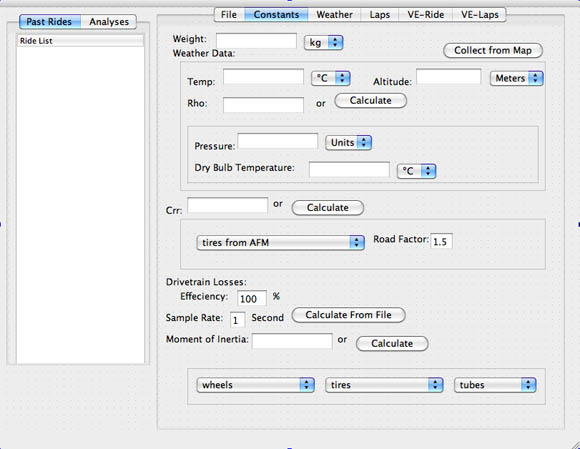
The abilty to overlay tabs is especially interesting as barometrically derived altitude is far from perfect, so the option of comparing a slow virtual elevation lap with a fast virtual elevation lap should be even more revealing.
I got the idea to incorporate the iBike’s wind data into Aerolab’s calculations (the original version assumes that air speed matches ground speed). Froncioni got me a patch in 24 hours, and the result was stunning.
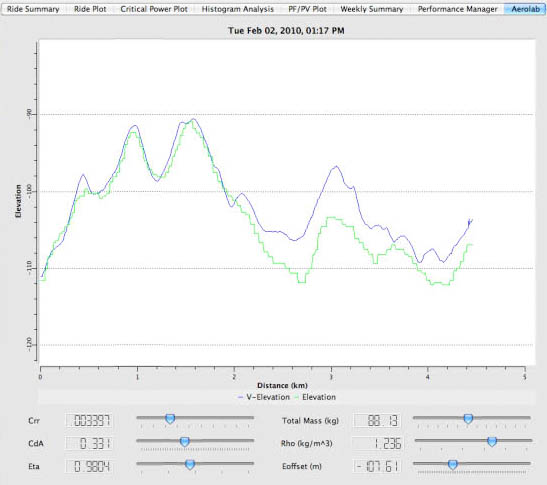
Here’s a short interval I did analyzed by the original version of Aerolab. There was nothing I could do to make the plots fit. I was starting to wonder if I had grabbed the wrong interval, one where I sat up instead of staying in the aerobars.
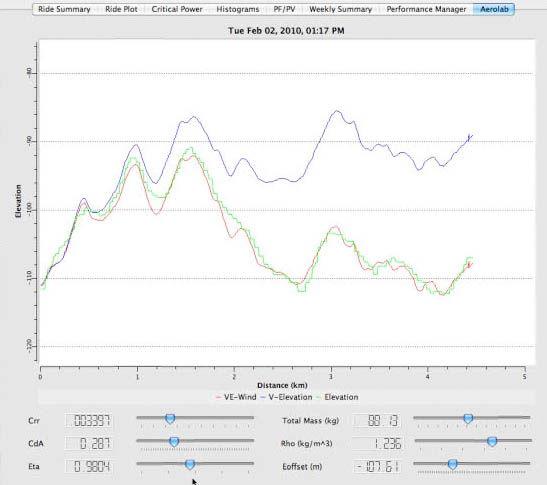
Here’s the same file with the iBike adjusted plot in red. There was a headwind that slowed me down, which Aerolab interpreted as an increase in pitch. With the headwind accounted for, the plots line up almost perfectly. This, to me, is a real testament to the iBike, and I’m more convinced that anyone who wants to play around with the Chung Method should do so with iBike paired with an ANT+ power meter.
Of course, none of this accounts for the effect of crosswinds. So could there be Aerolab hardware in the future?
1/29
Aerolab is Andy Froncioni’s brainchild, a virtual wind tunnel freeware tool that utilizes the Chung Method. A basic explanation of the Chung Method is here, but for now suffice it to say it’s a mathematical tool that lets you measure your aero drag with nothing but a power meter. Froncioni is still refining Aerolab, and hopes that it will be integrated as a tab within Golden Cheetah version 1.4 (1.3 is to be released soon).
Aerolab does a few cool things. First of all, it simplifies the Chung Method. Instead of manually extracting your power data and pasting it into an Excel spreadsheet, you can simply upload your data from your computer head into Golden Cheetah, or import an existing ride file. Aerolab creates the virtual elevation plot automatically, and you can tweak the plot with sliders for Cda, Crr, air density, and rider + bike weight.
Aerolab also adds another layer of data to the Chung Method. Whereas original Chung Method users had to do loops or out-and-back courses and level repeated landmarks on the course, Aerolab superimposes the course profile generated by your computer head over the virtual course profile, so you can compare the plots along the entire course. While the elevation plot generated by the altimeter in your computer head isn’t necessarily 100% accurate, it does provide more detail with which to analyze your ride.

The blue line is virtual elevation generated by Aerolab, the green line is actual elevation from my iBike’s altimeter. Tweaking the sliders will make the two lines match better.
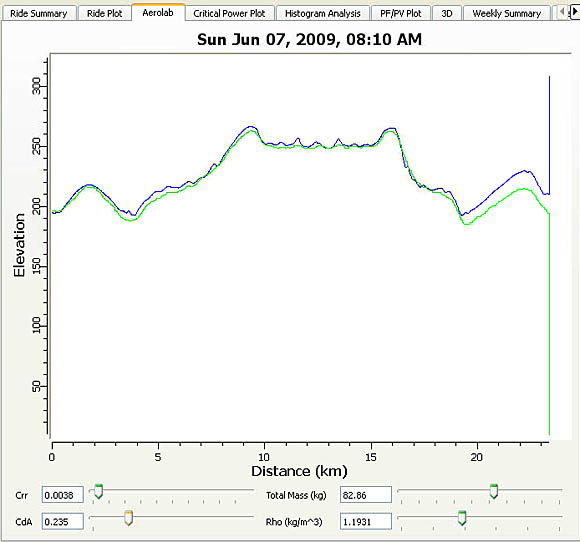
Here’s the same file, with better Cda/Crr estimates. Note how the VE plot is steeper on the last climb. I sat up at that point of the race, and the extra drag slowed me down. Since the Chung Method assumes consistent positioning, this slowing down is interpreted as a steeper gradient.
Aerolab is still in its infancy, and Froncioni is adding new features at a rapid rate. In cooperation with the eponymous Robert Chung, plans are currently in the works to include special views for superimposing loops and out-and-backs, as well as other course features. Provisions are also underway for tagging course segments with special attributes such as wind, road roughness, or a CdA multiplier. All this extra data will significantly help in finding the unique pair of parameters (Crr,CdA) that make the elevation profile ‘work’.
Further features include additional sliders for elevation offset and drivetrain efficiency, as well as a table of wheels that will allow you to correct for the extra momentum you get from the rotational inertia of your wheels. An auto solve feature will generate Crr and CdA values mathematically instead of graphically.
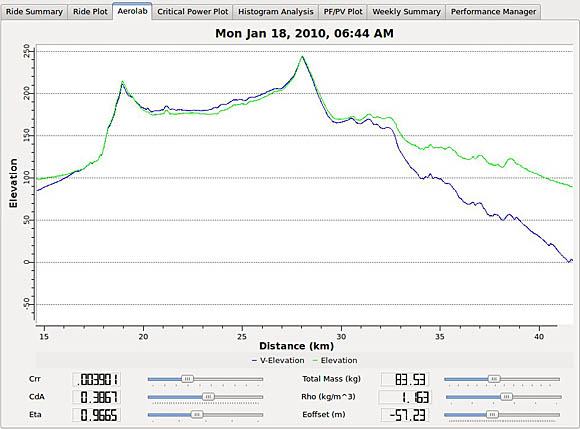
Here’s the next build of Aerolab, with sliders for drivetrain efficiency and elevation offset.
So why does Robert Chung think Aerolab is a ‘game changer’? Aerolab brings the Chung Method out of the realm of engineers and aero geeks and into the hands of anyone who can download a power meter file. Once Aerolab is complete you’ll be able to go out for a training ride, do an interval in one position, do another in a second position, and go home and find out which is faster. Want immediate feedback? Bring your laptop and analyze each run as you complete it. Breakaway artists can easily see if it’s faster to ride in the drops or with their elbows on the tops. Considering a new wheelset? Borrow a friend’s and see if it’s as fast as the manufacturer claims. And best of all, this will all be measured in real world situations while you pedal at race intensity, as you’re getting your training done.
You can download a PC version of Aerolab here and try it out for yourself. Just dig up an old TT file and import it (use files with little or no braking and no changes in position), and leave suggestions in Froncioni’s comments section. Once Golden Cheetah 1.3 is released, Froncioni will have Mac and Linux versions available for testing as well. Check back here or at his blog for updates.

Hi,
If you download this, try it, and have problems or feature requests, we are an Open Source project. Which means we deal directly with the user and we try hard to make sure all bugs get fixed and that you get a working copy.
But, to do so, you have to report the bug !
Please sign up to the Golden Cheetah mailing list and report your bugs/features:
http://groups.google.com/group/golden-cheetah-users
Oh and we accept patches too.
Thanks
J
This sounds really impressive. I have absolutely no clue what it means but sounds like a bunch of smart guys are behind it. Once I figure it out, park racing watch out, I’m going to be killing it.
This stuff is quite amazing, but we’re just simply making Robert Chung’s invention more visual.
And yes, Ruben Cable, Aerolab will help you kill it in your time-trials. Don’t be afraid to drop by and ask us questions, ok?
Cheers,
Andy
does this mean i can wang chung tonight?
Perhaps too late to ask, but looks as if you need something measuring actual elevation data during the ride for this to work. Is that correct?
DC
Nope, the actual elevation helps, but isn’t necessary. The real killer functionality is coming, the ability to take laps and overlay them. Comparing virtual elevation against itself will be very cool. You could do one lap slow and one lap fast, and then make the two plots match. Since Crr and CdA respond to speed differently, that would make very accurate results.
Hi, has the lap overlay feature been introduced yet in GC (6 years later!). I can’t figure out how to do it. I can compare laps on other views but not aerolab.
i smoke 2 laps before i smoke 2 laps, and then i smoke 2 more.
Thanks, Andy, for keeping on this thread. I’m not clear on how one can calculate Cda using Aerolab without actual elevation. With actual elevation, you can tweak the Cda slider to match Aerolab’s virtual elevation with the actual reading, thus getting an actual Cda. But without (as I have it), I just have one plot. I can move the plot up and down with the slider, but have no way of knowing what is more accurate. Or maybe there’s something I’m overlooking? Hence the post.
Also, your Cda on the examples is low! I guess all the testing and adjustments you’ve been doing has paid off. No surprise.
DC
Well if you’re doing loops, for example, you know that the net elevation always returns to zero.
If you do several loops at different speeds, then only one set of Crr-CdA combinations will level the ride data. The one thing you need to do is work with a very well-calibrated power meter.
Thanks for your question, and by the way — the CdA numbers are not mine. Obviously some people have gotten pretty good at lowering their CdAs.
Cheers!
Andy
if i improve my flexibility enough such that i can stick my head up my ass, will my cda improve?
Andy F is right about the laps. Another approach is to get the elevation of your start and end points from Google earth and make the plot have the same elevation change. Having the barometric elevation helps, but barometric elevation isn’t perfect either.
The CdA is mine, but that’s on a windless day. CdA’s you hear about are typically measured at 15 degree yaw, and will be higher as a result.
This is great stuff, Andy and Andy! It would be great if one could get a step by step, maybe once GC 1.4 is out, on how one could do a few runs and compare CdA if you _do not_ have Ibike (say using data from Google Earth and doing the loop around Grant’s tomb or a short loop in Central Park). Probably seems really simple to you all, but could be helpful for some of us.
Thanks!
DC
when i fart i’ll typically have a 5 degree change in yaw, but any potential decrease in drag is offset by higher inertia.
At what point does aero become relavent? is it when the rider is going above 16 miles an hour? 17 miles an hour?
It becomes relevant whenever you want to go faster for the same power or go the the same speed with less power.
go climb a hill in the aerobars and report back to us with less dismissive smugness.
http://www.powercranks.com/Lance.html
this is funny. lance doesn’t use powercranks but “he pedals as if he did” (not only that, but hey, check out this ed coyle study that proves it!)… so the logical conclusion is not that you don’t actually need a 1200 dollar crankset (that effectively renders an entire bicycle awkward useless) in order to improve pedal technique, but that you REALLY need it.
I am convinced, clicking Order…
http://sports.yahoo.com/sc/photo;_ylt=ArMQBqIOU3T5dsb7xam_HR9.grcF?slug=r3127601843&prov=reuters
Wow…that was insightful.
http://velonews.competitor.com/files/2010/02/Shiv-foto-2010.jpg
For sale: time trial bike, used very little.
funny. only 17K…
Free finger bang with purchase.
Thanks , I’ve recently been looking for info about this topic for a while and
yours is the best I have discovered till now.
However, what about the conclusion? Are you positive in regards to the supply?
my blog – evo sync charge cable
I’m not sure exactly why but this site is loading very
slow for me. Is anyone else having this issue or is it a problem on my end?
I’ll check back later on and see if the problem still exists.
my blog post; trifexis
What’s Going down i am new to this, I stumbled upon this I’ve
discovered It positively useful leptin and fat loss (http://bit.ly/15Ui6eq) it has aided me
out loads. I hope to contribute & aid other users like its aided me.
Good job.
Thanks. It works on so many levels.
So, I get that you think that was wrong. What I can’t figure out is which of the following two you think is right:
Please clarify so it’ll be easier to make fun of you.
Subscribe to the barrage of high-end handsets are family guy the quest for stuff cheats (x-prime.net) designed
with its excellent features. The game play but family guy the
quest for stuff cheats challenging as it provides remarkable experience of a slide driving technique.
oh stop it, you know exactly what the original question was about and you chose to be a dick, so you get dickishness in return.
Whoops. Sorry. Didn’t realize you NY guys were so sensitive. I apologize for hurting your delicate little feelings. I’ll go now. Ciao.
soooo…your stickin it to yourself???
actually, rawbiht, i am a suhly new englindah. but feel free to take youah chuhlishness elsewheyah just the same.
“At what point does aero become relavent? is it when the rider is going above 16 miles an hour? 17 miles an hour?”
Its always relevant, but it becomes more and more so as speed increases. Not just speed, but additional environmental wind has to factor into any calculus.
The effect of drag is logarithmic. By the time you reach 30 mph of wind the drag accounts for approx 80% of the energy required to move forward. Keep in mind you could be going 17 mph into a 10 mph headwind and the effective drag would be the same as going 27mph with no wind.
You sometimes hear that a specific wheel is better above 25 mph (HED makes this claim about some of their disc wheels for instance) This is because as forward speed increases, it tends to mitigate the effect of wind from the sides. (put your hand out the window of a car at 60 mph and even if there are strong cross winds you wont feel them.) So if you are going to build a wheel for faster riders who are averaging above 25 mph you would optimize the wheel for less yaw. Whereas if you are targeting a design for say a triathlon rider with average speeds in the low 20s, you would optimize the wheel for a greater spread of yaw values.
Steve Hed often talks about this and it seems to make a lot of sense.
You can check out their online YAW calculator here for the combined effects of head and cross winds on effective YAW:
http://www.hedcycling.com/aerodynamics_technology/yaw_calculator.asp
Aero lab software is really helpful for the people who work in industrial and technical departments. The graphical and the screen shot of the interface of Aero lab software bns chevron service gave me a clear idea regarding its working.